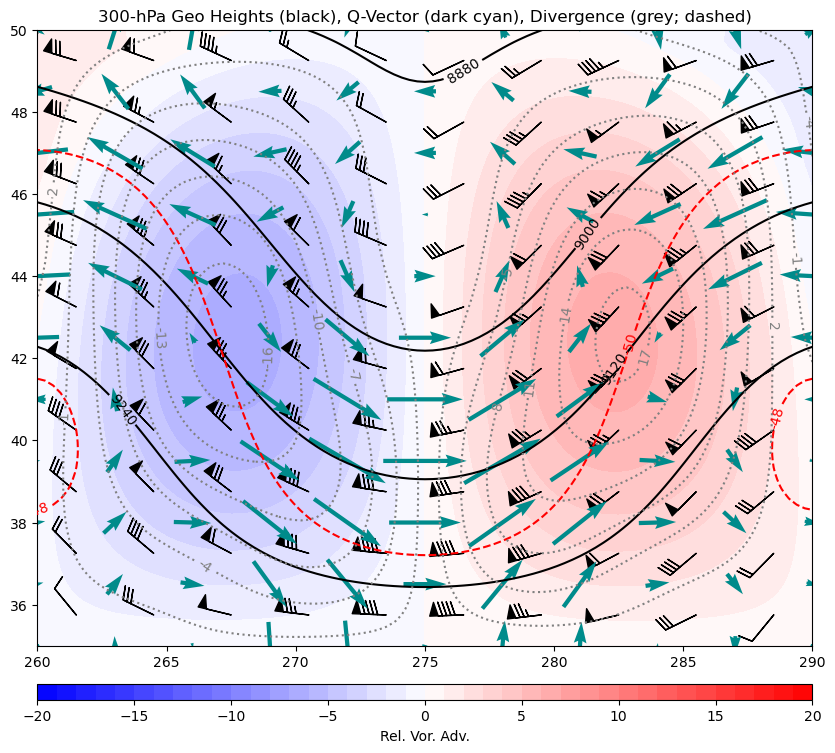import matplotlib.pyplot as plt
import metpy.calc as mpcalc
from metpy.units import units
import numpy as npBelow are three definitions to create an analytic 300-hPa trough roughly based on the Sanders Analytic Model with modified coefficients to create different style waves.
def single_300hPa_trough(parameter='hght'):
""" Single trough with heights and Temperatures based on Sanders Analytic Model
"""
X = np.linspace(.25, .75, 101)
Y = np.linspace(.25, .75, 101)
x, y = np.meshgrid(X, Y)
p = 4
q = 2
if parameter == 'hght':
return (9240 + 100 * np.cos(p * x * np.pi) * np.cos(q * y * np.pi)
+ 200 * np.cos(y * np.pi) + 300 * y * np.cos(x * np.pi + np.pi / 2))
elif parameter == 'temp':
return (-50 + 2 * np.cos(p * x * np.pi) * np.cos(q * y * np.pi)
+ 2 * np.cos(y * np.pi) + 0.5 * y * np.cos(x * np.pi + np.pi / 2))
def lifting_300hPa_trough(parameter='hght'):
""" Lifting trough with heights and Temperatures based on Sanders Analytic Model
"""
X = np.linspace(.25, .75, 101)
Y = np.linspace(.25, .75, 101)
x, y = np.meshgrid(X, Y)
p = 4
q = 2
if parameter == 'hght':
return (9240 + 150 * np.cos(p * x * np.pi) * np.cos(q * y * np.pi)
+ 200 * np.cos(y * np.pi) + 400 * y * np.cos(x * np.pi + np.pi))
elif parameter == 'temp':
return (-50 + 2 * np.cos(p * x * np.pi) * np.cos(q * y * np.pi)
+ 2 * np.cos(y * np.pi) + 5 * y * np.cos(x * np.pi + np.pi))
def digging_300hPa_trough(parameter='hght'):
""" Digging trough with heights and Temperatures based on Sanders Analytic Model
"""
X = np.linspace(.25, .75, 101)
Y = np.linspace(.25, .75, 101)
x, y = np.meshgrid(X, Y)
p = 4
q = 2
if parameter == 'hght':
return (9240 + 150 * np.cos(p * x * np.pi) * np.cos(q * y * np.pi)
+ 200 * np.cos(y * np.pi) + 400 * y * np.sin(x * np.pi + 5 * np.pi / 2))
elif parameter == 'temp':
return (-50 + 2 * np.cos(p * x * np.pi) * np.cos(q * y * np.pi)
+ 2 * np.cos(y * np.pi) + 5 * y * np.sin(x * np.pi + np.pi / 2))Call the appropriate definition to develop the desired wave.
# Single Trough
Z = single_300hPa_trough(parameter='hght')
T = single_300hPa_trough(parameter='temp')
# Lifting Trough
# Z = lifting_300hPa_trough(parameter='hght')
# T = lifting_300hPa_trough(parameter='temp')
# Digging Trough
# Z = digging_300hPa_trough(parameter='hght')
# T = digging_300hPa_trough(parameter='temp')Set geographic parameters for analytic grid to then
lats = np.linspace(35, 50, 101)
lons = np.linspace(260, 290, 101)
lon, lat = np.meshgrid(lons, lats)
# Coriolis Parameter
f = mpcalc.coriolis_parameter(lat * units.degrees)
# Calculate Geostrophic Wind from Analytic Heights
dx, dy = mpcalc.lat_lon_grid_deltas(lons, lats)
ugeo, vgeo = mpcalc.geostrophic_wind(Z*units.meter, dx, dy, latitude=lat * units.degrees)
# Get the wind direction for each point
wdir = mpcalc.wind_direction(ugeo, vgeo)
# Compute the Gradient Wind via an approximation
dydx = mpcalc.first_derivative(Z, delta=dx, axis=1)
d2ydx2 = mpcalc.first_derivative(dydx, delta=dx, axis=1)
R = ((1 + dydx.m**2)**(3. / 2.)) / d2ydx2.m
geo_mag = mpcalc.wind_speed(ugeo, vgeo)
grad_mag = geo_mag.m - (geo_mag.m**2) / (f.magnitude * R)
ugrad, vgrad = mpcalc.wind_components(grad_mag * units('m/s'), wdir)
# Calculate Ageostrophic wind
uageo = ugrad - ugeo
vageo = vgrad - vgeo
# Compute QVectors
uqvect, vqvect = mpcalc.q_vector(ugeo, vgeo, T * units.degC, 500 * units.hPa, dx, dy)
# Calculate divergence of the ageostrophic wind
div = mpcalc.divergence(uageo, vageo, dx=dx, dy=dy)
# Calculate Relative Vorticity Advection
relvor = mpcalc.vorticity(ugeo, vgeo, dx=dx, dy=dy)
adv = mpcalc.advection(relvor, ugeo, vgeo, dx=dx, dy=dy)Create figure containing Geopotential Heights, Temperature, Divergence of the Ageostrophic Wind, Relative Vorticity Advection (shaded), geostrphic wind barbs, and Q-vectors.
fig = plt.figure(figsize=(10, 10))
ax = plt.subplot(111)
# Plot Geopotential Height Contours
cs = ax.contour(lons, lats, Z, range(0, 12000, 120), colors='k')
plt.clabel(cs, fmt='%d')
# Plot Temperature Contours
cs2 = ax.contour(lons, lats, T, range(-50, 50, 2), colors='r', linestyles='dashed')
plt.clabel(cs2, fmt='%d')
# Plot Divergence of Ageo Wind Contours
cs3 = ax.contour(lons, lats, div*10**9, np.arange(-25, 26, 3), colors='grey',
linestyles='dotted')
plt.clabel(cs3, fmt='%d')
# Plot Rel. Vor. Adv. colorfilled
cf = ax.contourf(lons, lats, adv*10**9, np.arange(-20, 21, 1), cmap=plt.cm.bwr)
cbar = plt.colorbar(cf, orientation='horizontal', pad=0.05, aspect=50)
cbar.set_label('Rel. Vor. Adv.')
# Plot Geostrophic Wind Barbs
wind_slice = slice(5, None, 10)
ax.barbs(lons[wind_slice], lats[wind_slice],
ugeo[wind_slice, wind_slice].to('kt').m, vgeo[wind_slice, wind_slice].to('kt').m)
# Plot Ageostrophic Wind Vectors
# ageo_slice = slice(None, None, 10)
# ax.quiver(lons[ageo_slice], lats[ageo_slice],
# uageo[ageo_slice, ageo_slice].m, vageo[ageo_slice, ageo_slice].m,
# color='blue', pivot='mid')
# Plot QVectors
qvec_slice = slice(None, None, 10)
ax.quiver(lons[qvec_slice], lats[qvec_slice],
uqvect[qvec_slice, qvec_slice].m, vqvect[qvec_slice, qvec_slice].m,
color='darkcyan', pivot='mid')
plt.title('300-hPa Geo Heights (black), Q-Vector (dark cyan), Divergence (grey; dashed)')